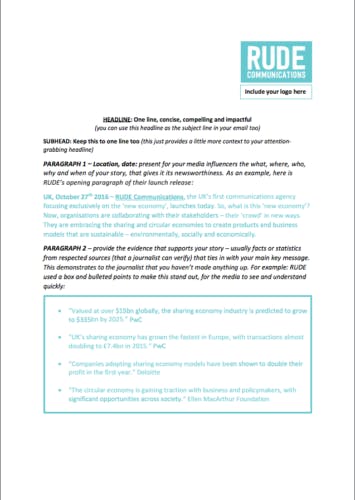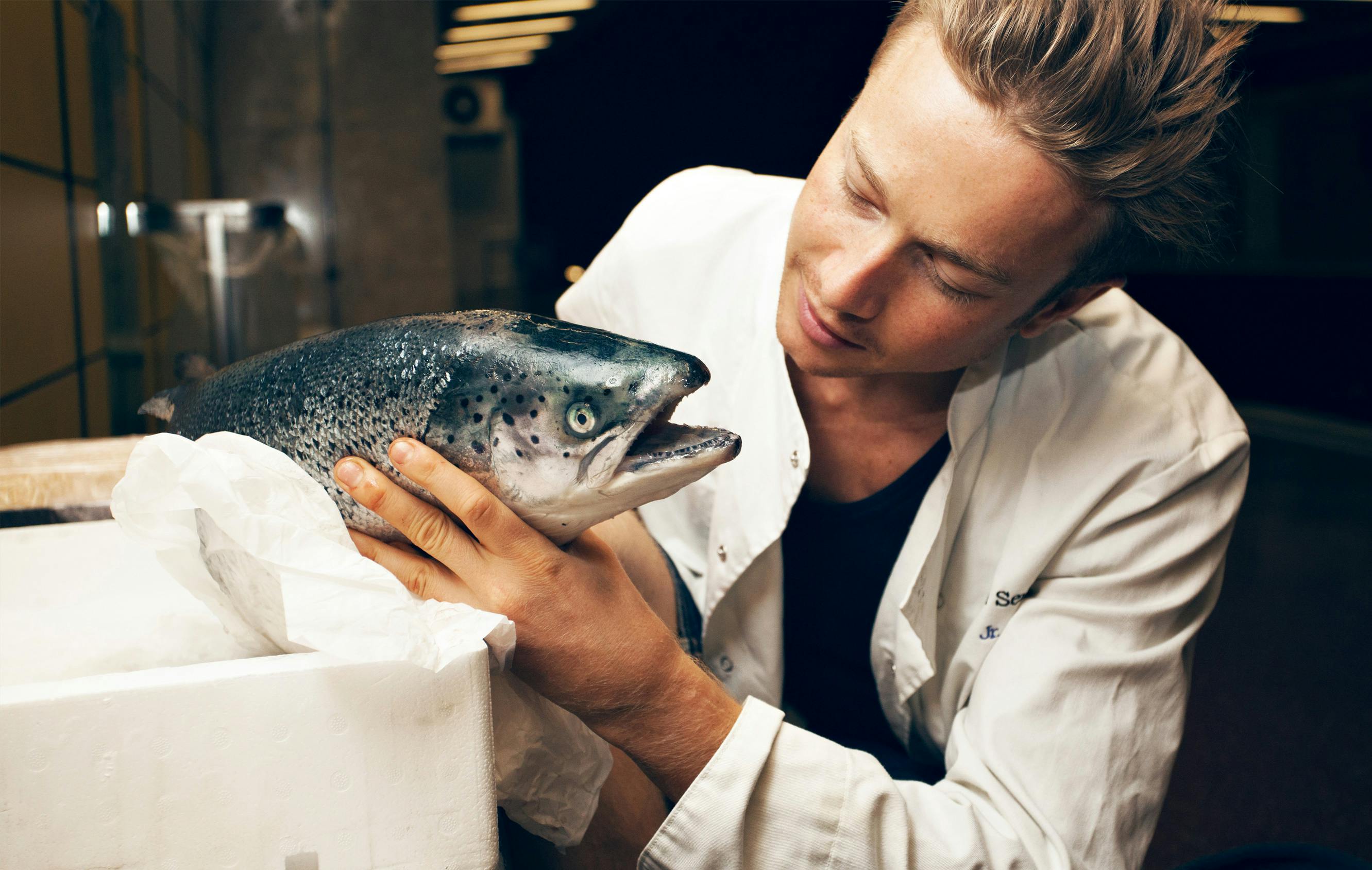How to use PR to grow your online marketplace business
Learn how to transform your sharing economy business with PR, and get a free professional press release template.
Published on
Last updated on

This is a guest post by Eve Laird and Elle Tucker of RUDE Communications - a PR and communications agency specializing in the sharing economy. For more tips on growing your business, check out the marketplace marketing & growth articles library.
In this age of technology-enabled connectedness, an expertly executed PR—public relations—strategy can transform your sharing economy business.
Today, PR is multi-channel. People consume their media from many different sources, be it from on- and offline newspapers and magazines, blogs, YouTube videos, infographics on Pinterest, TV, or radio. PR is also multi-influencer; journalists are no longer the sole source of editorials and opinions. Bloggers, celebrities, industry experts, and opinion leaders in your domain can exert a great amount of influence on your customers. Let's also not forget peer-to-peer influence through community groups and the like.
By taking a highly targeted approach to a seemingly complex media landscape, you can build the profile of your peer-to-peer marketplace, crowdfunding campaign, or other sharing economy initiative with a crowd that is unique to your specific offering.
In this article, we'll show you how you can use PR to grow your marketplace. And it's not just the theory; we've got some cool examples, too.
So, what is PR? Put simply, it's a way of communicating with your crowd through media. Traditionally, this would have been done via newspaper and magazine articles as well as TV and radio. Although this traditional model still holds true, it's only part of the picture.
How do you make sense of today's multi-channel, multi-influencer media landscape, and create a PR plan that fits your sharing economy business? Start by thinking about your media in four distinct but related categories:

This is the coverage generated in online and offline media by engaging the people who can influence your crowd. These influencers are the journalists, bloggers, vloggers, opinion leaders, high-profile personalities, and celebrities who will write about you, talk about you, and generally profile you on their media channels. In this article, we'll focus primarily on earned media—how to engage your influencers to secure coverage and exposure for your sharing economy business.
Owned media is the content you create and disseminate through your own channels: your website, your blog posts, your social media channels, white papers, ebooks, infographics, email campaigns, etc. Owned media lets you tell your story in your own way. It's also called "content marketing".
Shared media is the exposure gained through other people sharing your content online through social media and community groups. From online editions of newspaper and magazine articles to video and broadcast excerpts, and from blogs to Facebook, Twitter, Instagram, YouTube, Snapchat, and Pinterest, sharing via social media isn't just an alternative to traditional media—it's turning traditional media on its head. We'll touch on shared media in this article as well, since sharing your coverage—an article that features your product or service, for example—is important for gaining more exposure with your followers.
Unsurprisingly, paid media is media you pay for: boosted social media posts, paid-for social media posts on Instagram, Facebook, LinkedIn and Twitter, Google Adwords, advertorials, and advertising. Paid media is a wide topic that merits its own article, but you can get started with this article on using Google Ads for your marketplace.
- Are you running a crowdfunding campaign?
- Do you want to crowdsource ideas?
- Is awareness of your peer-to-peer sharing economy platform crucial for the growth of your business?
Whatever your objective for your PR campaign, this guide will help you target your crowd's influencers and achieve the media coverage you deserve.
Before you even think about your influencers, you must "know" your crowd. Understand their interests, what they are most likely to read, and where they hang out—both on- and offline. Knowing them will help you understand who they are most likely to listen to, whose opinion matters to them, and through which media channels they are most likely to consume news.
You can learn a lot about your crowd by building a followership on your social media channels, and tracking engagement with your content: checking out the profiles of your new followers and monitoring the likes, comments, retweets on your posts. This will let you understand who your followers are and which topics are most compelling for them.

Tip: create mood boards and avatars of your sharing economy participants. It will help you bring to life what type of people are following you, what content interests them, who they follow, and what media channels they use. You can create as many avatars as are appropriate for your business or service. This is basically a market segmentation exercise.
As an example, here is the avatar a potential customer for a home-sharing platform: Thomas.
Thomas is an engineer. He's liberal-minded and enjoyed traveling in his youth. He continues to enjoy outdoor sports and is now married with two small children. His wife is on a career break to look after their young children, and so they are living on one salary. Thomas is looking for creative ways of financially maintaining his lifestyle in the absence of his wife's salary. He has heard about sharing platforms that allow you to rent out your house while you're on holiday. Thomas likes the idea of life's luxuries—such as holidays—being cost-neutral. The income from renting his house would cover the cost of his holiday. He tends to read broadsheet newspapers and special interest magazines and blogs. He has a Facebook account and a LinkedIn account which he uses frequently. Thomas' interest in the sharing economy is financially driven.
Now that you know where your potential customer hangs out online and what media they consume, you can start to research the influencers you need to target. First, you need to identify who's writing about your industry niche. There are several ways to find influencers in your space.
Social media
Most journalists and bloggers maintain a profile on Twitter. Search for your niche along with "journalist", "editor", "blogger", or the name of a publication you want to target on Twitter. For example, searching for "sharing economy journalist" or "sharing economy blogger" will find articles and comments from journalists or bloggers who have written about the sharing economy.
Do different searches on keywords that relate to your sharing economy business and create a Twitter list of journalists. This helps you monitor what they are talking about.
Follow Twitter conversations relevant to your sharing platform industry to discover who are the most engaged participants. Keep track of relevant hashtags and see who is using them most actively.
Similarly, LinkedIn is a great channel for identifying people writing about your field. For example, searching for "Airbnb" will lead you to the Airbnb company page and interest groups that you can join. By joining interest groups, content posted by members of these groups will be shown in your newsfeed.
Search engines
You can also use a general search engine such as Google to do an online search of keywords relating to the industry your sharing economy business is operating in. For example, searching for "bloggers Airbnb" will lead you to several blogs: blog.airbnb.com, takeme-withyou.com, guesty.com, and so on.
Take a look at Google Trends, too. It's a tool from Google that tells you what terms people are searching for. You can use it to reveal new keywords to use in your search for influencers.
There are also specialized search engines for specific types of online media. For example, blogsearchengine.org can be used to only search blogs.
Online databases
There are many online databases of influencers. Although some charge for access, many provide limited functionality for free. Examples include Buzzsumo, Influence.co, and HypeAuditor.
Buy a list
Another option is to buy a list of influencers from a media company, but this is not something we generally recommend. It is better to put in the hard work to build a bespoke list of influencers for your specific needs, and then build long-term relationships with them that mutually benefit you both.
Now that you've found people who are writing and blogging in your space, how do you prioritize this database of potential influencers? You can measure the engagement a journalist or blogger has with your target audience by looking at three parameters:
- Reach
This is a quantitative look at how many followers they have on social media; the circulation of the publications they write for; the number of followers on their blog, etc. - Relevance
This is a more qualitative assessment about what they are writing about, and how well it fits with your objectives. Does their narrative fit with the key messages you would like included in any coverage? If you are doing a local campaign, do they cover your local area? Are their followers the right target market for you? Would your avatars from the profiling exercise like the author's content or page on Facebook or follow them on Twitter? - Resonance
Consolidating the information you have gained from looking at reach and relevance, you can make a judgment about the level of engagement your customer groups are likely to have with a particular influencer. Will my target customers see content from this influencer? Does this influencer write to their interests? The answers to those questions will help you determine how likely your target customers are to interact with and share the content on their channels.
Measuring the "Three Rs" helps you to prioritize your influencers and map out which key messages about your product or platform are most relevant for which specific influencers.
Once you have found and ranked your influencers, you need to start building a relationship with the people you think will be most aligned with your sharing economy offering. There are a few ways to do this.
Read their articles and blog posts
Is the journalist a freelancer writing for many publications, or is the journalist a staff writer at one specific title? Research the publications a journalist writes for to gain an understanding of the angles and media hooks that fit with the interests of their readership.
In addition to writing for newspapers, magazines, or other publications, many journalists manage a blog and personal website to showcase their work. It's a good idea to read through them as well.
The same thing goes for bloggers—make sure you know what they write about and who they are blogging for.
Be social
Journalists and bloggers are people, too. When you make an approach, they want to feel like you understand them and their readership—and that they are not simply the gateway to your media coverage. So: follow them on Twitter, LinkedIn, and other media channels. Like, retweet and comment on their work. This will help you get noticed so that when you eventually do have your own story to share, they already know a bit about you. You may even have talked with them or shared some dialogue through personal messages.
Offer them something
- Guest blog
Create content (such as a blog post) which is published on a blogger's blog. The advantages of guest posts are two-fold: your ideas are being delivered to that blogger’s audience, and by accepting your content, your influential blogger is showing their endorsement for you. Talk to an influential blogger, get to know what they write about and who they are writing for, and pitch a post for their blog. Bloggers, just like journalists and other writers, are always on the lookout for high-quality, relevant content. Make their life easier by providing insights and knowledge their readership will love. You can read more about how to create an engaging hook below. - An exclusive
If you have a truly newsworthy story, you may consider offering it as an "exclusive" to your highest-value influencer. This may be a journalist writing for a leading journal, magazine or newspaper—one that is highly respected by your crowd.
You know your crowd. You've found and ranked their influencers. How do you now get these important influencers to write about you? It's all in the hook: the story about your product or service that is newsworthy. The hook needs to be current and relevant. There are several different approaches to finding a great media hook that is right for you:
New launch
Do you have something new? Are you launching a new sharing platform, offering a unique experience for people? Are you launching a marketplace crowdfunding campaign to finance a new concept or idea? The more unique, new, and interesting the pitch, the more the media will want to cover it.
Brand yourself
Perhaps you have an interesting personal story to tell. What's your background? What was the journey to creating your sharing economy business like? You can share your passions, your experiences, and what drives you—as an individual, you are unique with a unique story to tell. When crafting your profile piece for the media, be honest and humble about your success and failures. Your brand will create a compelling and captivating media hook, with emotional resonance to boot.
Awards
Have you won an award? Many platforms recognize and reward innovation and new business. Whether you're a social enterprise, a marketplace, or a product innovation, make your plaudits your news too.
Data
Create qualitative or quantitative data—hard facts that validate a trend, a problem that needs solving, or the market's readiness for your marketplace or product innovation. You can do this by creating and distributing a survey to poll opinion, or by citing expert material. The poll can be global, national, or local, depending on your marketplace.
Expert knowledge.
Perhaps you are an opinion leader in your chosen field. Do you have academic credentials? Have you done original research? Do you have experience and a knowledge base that makes you an expert? What information can you share that expands the knowledge of others?
Seasonal
Your marketplace or product may have seasonal relevance. For example, if you are offering a campervan rental service, do people rent campervans more frequently in the summer months? Think about creating a campaign that ties in with seasonal demand for your product or marketplace offering.
Local
If your sharing platform services a local market, craft a story with a strong local angle and send it to the local media (with a little nurturing of local journalists) to gain exposure with a local readership.
Event
Create an event or a fun stunt that you can invite journalists to.
Trending news
Do you have something relevant to contribute to a topic that's trending in the news? Let's say that slow fashion is a trending hashtag, and you offer a platform for vintage dress rental. Create a link between the conversations happening around slow fashion and your marketplace.
Your competitors
Do a little due diligence. Who do you consider as your competitors? Are they in the media? If so, which story angles have they used to gain coverage and raise their profile? This might spark new ideas!
You've decided on your story hook and you know the influencers you want to engage with—now it's time to create your media materials. Make sure it includes:
- Media release, including contact information
- Notes to editors
- Hi-resolution images such as photographs of your sharing economy brand visuals, headshots of the founding members, your logo, etc.
- Other media assets such as video
- Where it's relevant, a product sample

The main aim of a media release is to communicate the newsworthiness of your story, irrespective of the hook you've chosen. To transform your hook into a compelling piece of potential editorial that your media influencers will want to write about, it can be helpful to ask yourself the following question: why is my story interesting to my media influencers' readerships?
For example:
- What is it about my story that is so new? What can people learn that they didn't already know?
- What beliefs or perceptions does my story confirm or contradict? Is there something surprising or unexpected about my findings?
- What problem does the solution in my story solve that hasn't been solved before?
Once you've answered the why—why will my story matter to people?—you then need to distill it down and capture it in a killer headline or email subject line. Journalists are incredibly busy, and if they don't understand what your story is about with a concise, compelling, and impactful subject line, they will quickly move on.
They've opened your email—yay! But the hard work isn't over. Again, the journalist will scan your first line, looking to see if you deliver on the promise of your headline. It's your job to make the journalist's life as easy as possible. When crafting your opening, think about the "Five Ws"—what, where, who, why, and when—and communicate the most important part of your story at the very beginning of your release. Put yourself in the shoes of your media targets. Imagine the opening of a story, and this should give you your first line.
Try to keep your media release to a single page—around 300-400 words. Three or four short paragraphs and one or two quotes is a good structure. Once you've set out your story in the first paragraph, the rest of the release should support that story by providing facts and statistics as well as quotes from respected authorities.
For example, a rough structure might look something like this:
Paragraph 1: the what, where, who, why, and when of your story. The stuff that gives it its newsworthiness.
Paragraph 2: the supporting evidence—facts or statistics from respected sources (that a journalist can verify) that tie in with your main key message. This demonstrates to the journalist that you haven't made anything up.
Paragraph 3: provide more detail: why your marketplace is needed, and why you are well suited to creating this marketplace.
Paragraph 4: a quote, possibly from the founder or CEO of your organization.
Paragraph 5: a quote from someone external to your organization—a respected independent third party. Always remember to ask for their permission. There is often an opportunity to write the quote on behalf of your nominated spokesperson, which they can then approve.
You can use formatting to make information stand out, and key facts and figures easier to digest. For example, put key stats in a box or bulleted list. A contact name and number for the media to get in touch and ask any questions should immediately follow the end of your release.
Any additional information about your organization, its founders, the market it is operating in, and anything else that is relevant to your story should be included in a separate "Notes to editors" section at the end.
Now it's time to send your materials to your media targets. But a one size fits all approach won't work. Your media targets will have different readerships and different interests, making it important to tailor your materials to meet their needs. This doesn't necessarily mean a complete re-write—minor tweaking might suffice. For example, include specific keywords relevant to their readership, a quote from a person relevant to that community, etc. These are easy ways to demonstrate that you've written your story with their needs in mind.
We talked earlier about finding and nurturing your influencers. This hard work will finally start paying off when you start distributing your media materials. You should write a short paragraph to introduce your release. Reference your relationship, and note any relevant recent articles they have written. You can also suggest where your story may fit into their blog or publication. Paste the media release below this paragraph—busy journalists may not always open attachments. Don't send big photo files that will clog up their inbox—instead, direct them to where media assets can be found online. Make sure you tag any links in your release so you can track where the traffic originated from when it lands on your site.
This approach requires a very personal touch. You should manually send the media release to the personal address of your influencers. There are, of course, newswires, but we recommend a highly targeted approach with your highest-value influencers. Where appropriate, you can augment this with a more general release on a newswire. And don't be afraid to follow up: sometimes people are just busy, and stories are missed. Pick up the phone or send an email.
Great news! Firstly, thank the media influencer who's featured you. Then leverage the power of shared media to distribute your news beyond the readership of that journalist or blogger. Post on your website, share on all your social media channels, and encourage engagement from your followership with shares, likes, and comments. By tagging the writer and the magazine in your post, their followers see it too, helping you grow your crowd. And not only that, because the article has been written by an influencer—someone outside of your business, with an objective point of view—it gives your business that valuable third-party endorsement.
We hope we've given you a useful guide to engaging with media influencers that you can apply in your sharing economy business. To bring the theory to life, below are some examples from sharing economy companies who have worked effectively with the media to share their brand message with their crowd.
Veridu provides a range of global digital identity solutions, with a mission to bring trust to the internet. To create a newsworthy media hook to generate coverage, Veridu conducted a survey. They did this in collaboration with The People Who Share, a social enterprise that helps people and companies discover and access the sharing economy. The survey asked over 850 consumers in both the United Kingdom and the United States about their views and interactions with the sharing economy. The campaign yielded compelling data that Veridu used to create a platform to raise their profile in the media. For example:
“Research shows that lack of trust is the biggest barrier to consumers' trying out a sharing-economy service.”
“More than a third of people polled in the US and UK have never used a sharing-economy service because of concerns about personal safety and fears that their possessions will be damaged or lost.”
Here is a selection of the coverage they achieved:
Veridu leveraged their earned and owned media surrounding the survey activity to maximize the impact of the survey results:
- They created an eBook of the findings from the survey.
- The results and eBook were promoted via media releases distributed to a range of national, regional, and trade titles.
- The eBook was edited into a blog post that appeared on Veridu's blog.
- Media coverage was posted to Veridu's online newsroom.
- Results were communicated through social media using Twitter, LinkedIn, and Facebook channels. The top tweet achieved 7,149 impressions, the highest engagement on a post to date.
- Google Analytics demonstrates that coverage and social media promotion of the survey results drove an uplift in inbound traffic to the Veridu website.
Phytl Signs (later renamed to Vivent Biosginals) is a unique, groundbreaking device that lets people hear and see plants communicating—they do!—through their language of electrical signals.
Phytl Signs wanted to crowdsource data from users of the device to create the evidence base needed to decode the language of plants. They used a crowdfunding platform to validate their idea and source their crowd.
The newsworthy media hook for Phytl Signs was the originality of the product. The fact that Phytl Signs were crowdfunding, too, was a secondary message. Since crowdfunding (as an activity) has moved into the mainstream, it is generally not considered a particularly newsworthy hook with journalists and bloggers. Therefore, the news hook focused on what the device was able to do both now and in the future. Through a highly targeted influencer engagement piece, an exclusive was pitched to an on-staff journalist with a doctorate in plant biology at New Scientist, the world's leading consumer science journal. The Phytl Signs story was a good fit for the innovative, forward-looking editorial of the journal, and it also piqued the personal interest of the journalist.
Because of the exposure gained through a highly-respected title such as New Scientist, other magazines, journals, and newspapers covered the story too.
Media outreach achieved coverage in over 128 publications globally, reaching an estimated audience in the millions, across a broad spread of titles targeting the Phytl Signs market segments. The highest-reach publications included mass-market consumer press such as the Daily Mail, Metro and Zee News; thought-leading and influential science title New Scientist; technology and futurology focused media such as Gizmag, Trend Hunter and Wonderful Engineering; and leading gardening-related publications such as Horticulture Week.
Advances in technology are the enablers of new economies such as the sharing economy, and it's also changing how we communicate and interact with each other. Still, the principles of that communication and connectedness don't change. At its heart, PR is about engaging with people—sharing information, insights, and knowledge for everyone's benefit. Your media influencers gain great content, and your sharing economy business gains great exposure and endorsement.
Know your influencers—their interests and those of their readership. Pitch a story you know their readership will love. Make their life easy by providing content and media assets in a format they want and will use. Be helpful when responding to questions. In other words, get to know your media influencers as individuals. Engage with them as people, and not just as a conduit to your media coverage.
Today’s multi-channel, multi-influencer media world provides huge opportunities. By using different influencers—each with their own audience that represents a unique segment of your own crowd—you can engage with your entire ecosystem of stakeholders in ways that are targeted and relevant.
You might also like...

Marketplace metrics: 26 key metrics and how to use them
What metrics should a marketplace founder track? And how to translate what you track into action? Here’s how to identify and track the key metrics, how to separate them from vanity metrics, and how to make concrete decisions based on reliable data.

How to start with branding your marketplace
Use the brand strategy canvas to find your unique marketplace positioning.

Adapt to the local context – An interview with Joel Serra
Quality over quantity—an essential part of EatWith's success.
Start your 14-day free trial
Create a marketplace today!
- Launch quickly, without coding
- Extend infinitely
- Scale to any size
No credit card required
